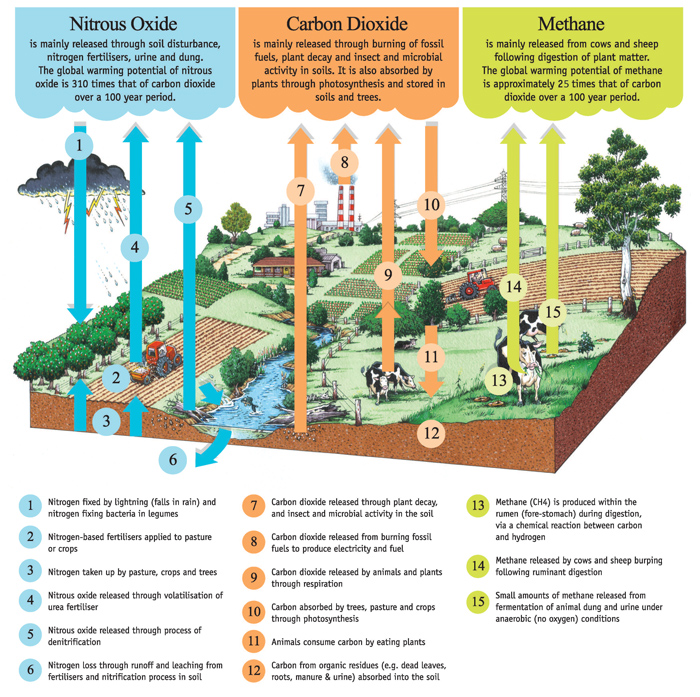Greenhouse gas cycles in agriculture
Moving and transforming as they move through our farming systems, greenhouse gases are absorbed and released over different time scales and in a range of quantities.
The following graphic shows the fluxes of the greenhouse gases nitrous oxide, carbon dioxide and methane in and out of a typical farming system.
Note: This information is focused on greenhouse gas emissions from the agricultural sector. It doesn't include other emissions from other industries.

Nitrous oxide (NO2)
Nitrous oxide (NO2) gas is mainly released through:
- soil disturbance
- nitrogen fertilisers
- urine
- dung.
The global warming potential of nitrous oxide is 310 times that of carbon dioxide over a 100 year period.
Nitrous oxide moves through the atmosphere and landscape in the following ways:
- Nitrogen is absorbed by lightning, which then falls in rain. Atmospheric nitrogen is also converted into inorganic nitrogen compounds by nitrogen fixing bacteria in legumes which are usable by plants.
- Nitrogen-based fertilisers are applied to pasture or crops.
- Nitrogen is taken up by pasture, crops and trees.
- Nitrous oxide is released through volatilisation of urea fertiliser.
- Nitrous oxide is released through the process of denitrification.
- Nitrogen is also lost through runoff and leaching from fertilisers and nitrification processes in soil.
Carbon dioxide (CO2)
Carbon dioxide (CO2) gas is mainly released through:
- burning of fossil fuels
- plant decay
- insect and microbial activity in soils.
It is also absorbed by plants through photosynthesis and stored in vegetation and soils as carbon.
Carbon dioxide moves through the atmosphere and landscape in the following ways:
- Carbon dioxide is released from soil through plant decay, and insect and microbial activity in soil.
- Carbon dioxide is released from burning fossil fuels to produce heat, electricity and fuel.
- Carbon dioxide is released by animals and plants through respiration.
- Carbon dioxide is absorbed by trees, pasture and crops through photosynthesis and converted to other complex carbon compounds and oxygen.
- Animals consume carbon by eating plants.
- Carbon from organic residues (for example, dead leaves, roots, manure and urine) is absorbed into the soil.
Methane (CH4)
Methane (CH4) gas is mainly released from:
- rice paddies
- coal mining
- landfill sites
- ruminant livestock such as cows and sheep (following digestion of plant matter).
The global warming potential of methane is approximately 27 times that of carbon dioxide over a 100-year period.
Methane moves through the atmosphere and landscape in the following ways:
- Methane is produced within the rumen (fore-stomach) during digestion, via a chemical reaction between carbon and hydrogen.
- Methane is released by cows and sheep burping following ruminant digestion.
- Small amounts of methane is released from fermentation of animal dung and urine under anaerobic (no oxygen) conditions. Methane is also released from dairy waste water settling ponds.
Action areas to reduce emissions
There are many practical ways to prevent the losses of greenhouse gases which typically coincides with improved farm productivity. These are explained in the 'Making cent$ of carbon and emissions on-farm' booklet.
Learn more about ways to improve farm productivity and reduce greenhouse gas emissions in the following action areas: